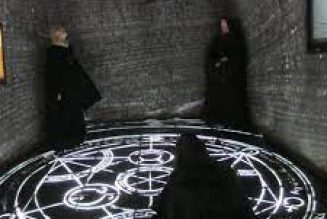Even if you are already well versed in Astrology, I encourage you to read this chapter carefully as there are
specific nuances and perspectives that relate to its use in Magick that are not part of standard instruction in the principles of Astrology.
In fact, some of the standard model of Astrology that is used for mundane purposes is somewhat out of alignment with its use in Magick.
For those that are already knowledgeable, there may be a need for some relearning.
For those that are new to the sacred science of Astrology, do not worry if you have tried to learn this before and found it confusing or difficult.
The material will be presented with a bare minimum of mathematics and an abundance of metaphors and analogies that will allow you to grab the essence of the discipline.
You will not be able to do your birth chart after reading this chapter, but you will be prepared to make use of the ideas and techniques presented in the remainder of the book.
Because you’re reading this book, it is a fairly safe bet that you have some concept of there being multiple planes of reality and multiple worlds.
The most common pattern in Western magickal traditions is that of the Earth plane being the densest and then some number of planes rising up or surrounding us that are described as being less dense or of higher vibration.
When we look at an astrological chart, what we are actually looking at is a map that is an attempt to summarize and to flatten those multiple planes into an understandable diagram.
An astrological chart is a sort of magickal cartogram that displays data in a simplified and abstracted manner.
Returning to the analogy of the Celestial Temple from the previous chapter, let’s examine the three primary layers that are condensed into a chart.
Think of the Planets as being the top level and as sources of light, emanations of particular qualities.
Think of the 12 Signs of the Zodiac as being the next layer down from the Planets.
Think of the layer of the Signs as being a mandala made of 12 sections of ornate stained glass, each made of carefully arranged colors and shapes that represent the qualities of the Signs.
Now imagine the floor of the Celestial Temple with a mosaic that depicts a circle divided into 12 wedges, the 12 Houses.
The light of the Planets passes through the panes of the 12 Signs, and creates a pattern upon the mosaic of the temple floor.
When we look at the pattern on the floor of the Celestial Temple, we are looking at an astrological chart.
Depending upon the positions of the lights around the Celestial Temple, their intensity, and the slant of the lights, different patterns and, different charts are produced.
If we think of Astrology as also being a magickal language, then you can image that a chart is a like a long poem or a richly packed short story.
Each line is filled with depths of meaning and more becomes revealed with each reading.
If you are a lover of words, then I ask that you think about the following comparisons as you work your way through this book.
Planets can be thought of as acting like nouns.
The Signs can be thought of as the equivalent of adjectives and adverbs.
The Aspects between the Planets can be thought of as verbs.
The Houses provide structure for the phrases and clauses.
There are other parts of speech and other parts of astrological charts, but for the sake of not bogging down the learning process by getting too many details at once, let’s keep it to just these few things in your initial contemplation of the language of Astrology.
You will have to memorize the alphabet of Astrology.
By that I mean that you will need to at the very least commit to memory the glyphs for the Planets, Signs, and the Aspects as they are presented.
As is often true in the learning of a new language, at first you will be translating the Astrology into your native language.
After a time, you will look at astrological information and simply read it and understand without pausing to translate it.
At that point you’ll begin to become aware of “words” that exist in Astrology that do not exist in your native language.
That is when you will become aware of just how much your thought process is expanded by the addition of new vocabulary.
Once you are fluent in Astrology, skills from any other divinatory system that you know can be brought to bear on reading astrological information.
For example, if you have experience using the Tarot as a divinatory system, then you may contemplate an astrological chart as if it were a spread.
Once you have grasped and internalized the meanings of the fundamental building blocks of Astrology you will not simply see squiggles, glyphs, and numbers when you look at a chart; instead, you’ll see images, situations, tensions, and resolutions.
If you are a good tarot reader, you do more than simply repeat the assigned meanings for the cards in their locations.
Your intuition and imagination allow you to see a story built up from the images.
When I first started my astrological studies in the 1980s, I had to learn how to construct a chart the hard way.
This meant a goodly amount of time spent with my ephemeris, books of tables, a pocket calculator, pencils, paper, and drafting tools.
It took a significant amount of work to convert the birth time, date, and latitude and longitude of a birthplace into a useful chart.
If you intend to become an astrologer, there is great value in learning how to do it from scratch.
However, for most of the magickal purposes you may have in mind, this is unnecessary.
Almost all the information you need can be found in readily available astrological calendars, online chart calculators, and software that you can install on your computer to do the math and charting for you, if you so desire.
Moreover, as you’ll discover later, there are quite a number of very practical magickal techniques that do not require the use of a chart at all.
Should you find yourself inspired to pursue the study of Astrology beyond what is needed to augment your magickal practices, I’d like to offer you a few suggestions.
Be kind to yourself and have reasonable expectations for your rate of progress.
I’ve mentioned several times that Astrology is like a language. Even people who have a natural gift for acquiring languages require time and
practice to become truly proficient.
Also, the discipline of Astrology is vast, a vastness that comes from centuries upon centuries of experimentation and refinement.
I’ve encountered many people who, in the thrill of discovery, continue to collect tools and techniques without having first mastered the basic tools.
I have known excellent carpenters who could produce beautiful furniture with the simplest of tools, and hobbyists who could do much less despite having a whole shop full of specialized saws, bits, and routers.
Be patient and don’t berate yourself for not being a quick study; there is no such thing as that when it comes to Astrology.
The good news is that remarkable things can be accomplished with just the essentials provided in this book.








